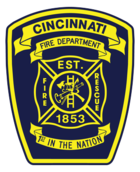History
Early Beginnings
The Cincinnati Fire Department traces its origins to the early 19th century when fire protection services were minimal and mostly volunteer-based. By the 1800s, Cincinnati's population had increased significantly, making the need for organized firefighting more urgent.
In the 1830s, the city began developing its volunteer fire companies. These early fire brigades operated on a rotating basis, with volunteer firefighters often working without pay and relying on personal equipment, such as hand-drawn pumps, to fight fires. Despite these efforts, major fires like the Cincinnati Great Fire of 1845 revealed the inadequacies of the city's fire protection system.
The Cincinnati Fire Department as it is known today was founded on April 1, 1853, with the establishment of the nation's first fully paid professional fire department. This transformation from a volunteer to a professional force marked a significant shift in fire service operations.
The change came after the devastating fire at the Eagle Ironworks in 1852, which caused considerable property damage. As a result, city officials recognized the need for a more structured and effective firefighting force. A combination of local political pressures and the city's growing demands for better safety led to the creation of the CFD.
The first chief of the department was Miles Greenwood, an influential Cincinnati industrialist and inventor who had previously helped develop some of the early firefighting technologies. Under his leadership, the CFD began modernizing and equipping its fire stations and personnel with steam-powered fire engines and other advanced tools of the trade.
Expansion and Technological Advances (Late 19th Century)
By the late 1800s, the department had expanded its reach and capabilities. The CFD was one of the first to incorporate steam-powered fire engines and later motorized vehicles to improve response times and efficiency.
In the 1870s, the city began using fireboats to protect the waterfront and handle fires on the river, which was a critical aspect of Cincinnati’s infrastructure due to its location along the Ohio River.
Additionally, the department began implementing fire prevention measures and public education campaigns to reduce fire risks, a concept that would grow to become a vital part of firefighting strategy in the decades to follow.
Fire Prevention and EMS Integration (Early to Mid-20th Century)
The Cincinnati Fire Department adapted to the changing needs of the city throughout the early 20th century, incorporating fire prevention and safety measures into their work. Firefighters began engaging in community education programs, focusing on fire safety in homes, schools, and workplaces.
In the 1920s, the CFD expanded its role by taking on a rescue mission. They began training personnel to provide more advanced medical care at the scene of accidents and fires, eventually leading to the integration of Emergency Medical Services (EMS) into the department.
By the 1950s, the Cincinnati Fire Department had also introduced Hazardous Materials (HazMat) teams to handle dangerous chemical spills and other toxic threats. This marked a new era of firefighting and rescue operations, as the department continued to evolve and incorporate specialized training and equipment.
Modernization and New Challenges (Late 20th Century to Present)
The Cincinnati Fire Department saw continued modernization in the late 20th and early 21st centuries. The department implemented advanced life support (ALS) techniques, providing critical care to patients during transport in addition to responding to fires. This was part of a broader effort to improve service to the community by not only responding to fires but also offering pre-hospital care and rescue services.
In the 1980s and 1990s, the CFD responded to a series of complex incidents, including large-scale fires in industrial and residential areas, toxic chemical spills, and urban disasters. As the city continued to grow, the department made sure to expand its services to meet the evolving needs of the community.
The Cincinnati Fire Department now operates 26 stations, with a staff of approximately 624 personnel, providing critical services such as:
- Fire Suppression: Responding to structural and wildland fires.
- Advanced Life Support (ALS): Providing emergency medical care, including CPR, advanced airway management, and drug administration.
- Technical Rescue Operations: Rescuing people from collapsed buildings, trench rescues, and swift-water rescue.
- Hazardous Materials Response: Handling toxic and hazardous spills or incidents.
- Fire Prevention and Education: Offering programs to educate the public about fire safety, home fire prevention, and disaster preparedness.
Today, the CFD continues to be at the forefront of urban firefighting, equipped with modern tools and committed to reducing the impact of fires and medical emergencies in the community.
This page is based on this
Wikipedia article Text is available under the
CC BY-SA 4.0 license; additional terms may apply.
Images, videos and audio are available under their respective licenses.
